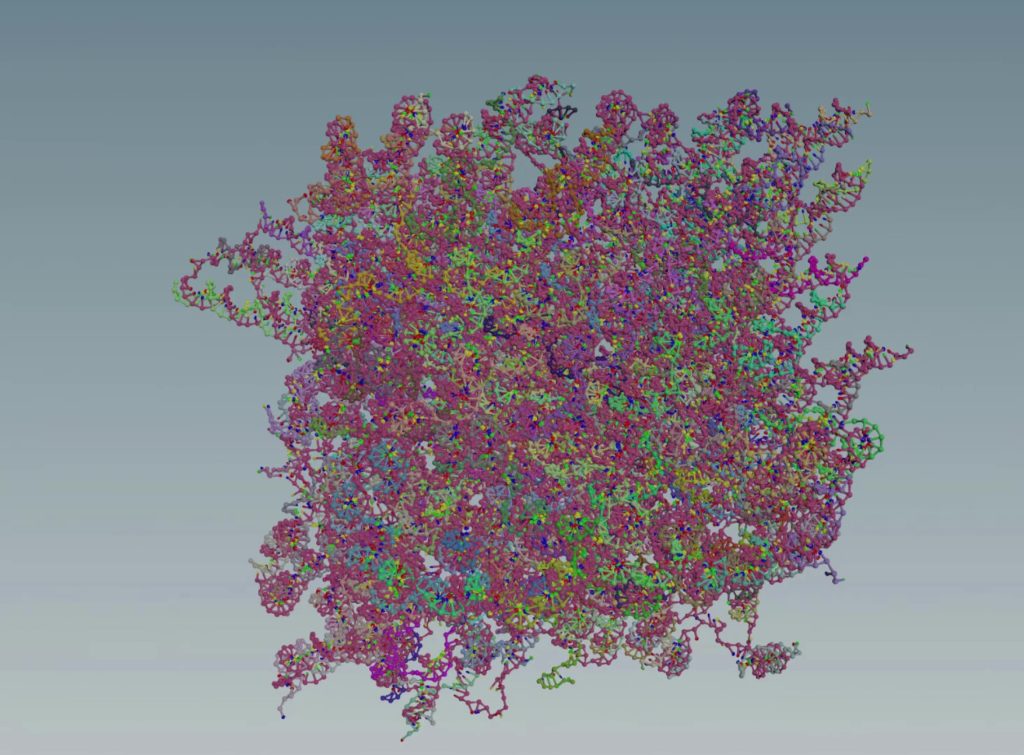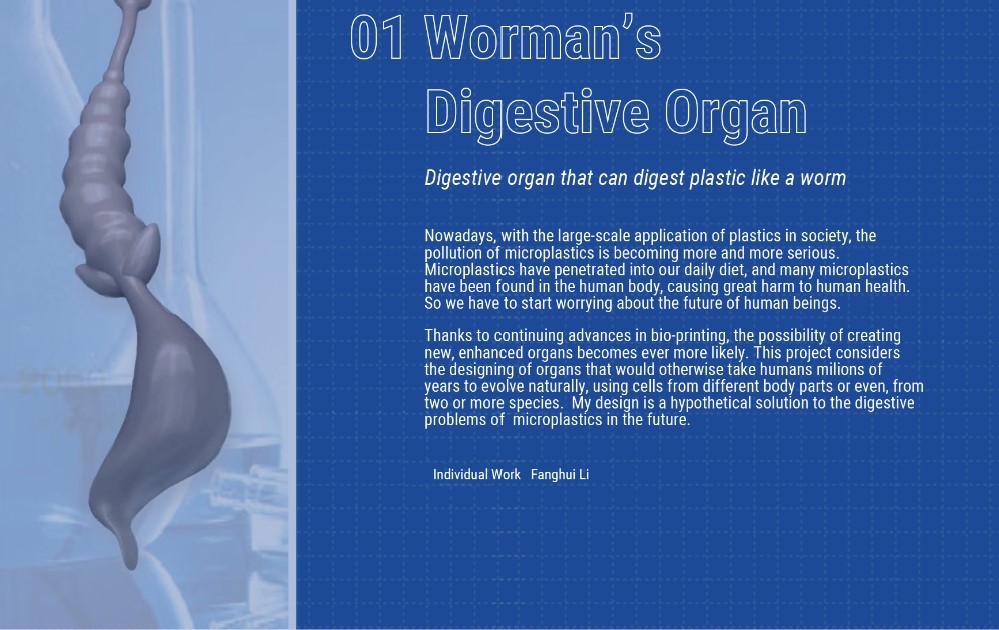
How can Design methods help/be used in the context of Bioinformatics and related projects?
1st Prize Winner: Eden Harrison
| Name | Eden Harrison |
| University | RCA (UK) |
| Program | Innovation Design Engineering |
| Inspiration Brief | Independent |
Bioinformatics in Ecoacoustics
We propose a new abstraction space that has a continuum of visual representations for the explanatory analysis of molecular dynamics simulations in the DNA nanotechnology domain. By re-purposing the commonly used progress bar and designing novel visuals, as well as transforming the data from the domain format to a format that better fits the newly designed visuals, we compose a set of new representations. This set is also designed to be capable of showing all spatial and temporal details, and all structural complexity, or abstracting these to various degrees, enabling both the slow playback of the simulation for detailed examinations or very fast playback for an overview that helps to efficiently identify events of interest, as well as several intermediate levels between these two extremes. For any pair of successive representations, we demonstrate smooth, continuous transitions, enabling users to keep track of relevant information from one representation to the next. By providing multiple representations suited to different temporal resolutions and connected by smooth transitions, we enable time-efficient simulation analysis, giving users the opportunity to examine and present important phases in great detail, or leverage abstract representations to go over uneventful phases quickly. Domain experts can thus gain actionable insights about their simulations and communicate them in a much shorter time. Further, the novel representations are intuitive and enable researchers unfamiliar with MD analysis graphs to better understand the simulation results. We systematically place them in a visualization space, SynopSpace, composed of three axes: granularity, visual idiom, and information layout type.

2nd Prize Winner: Deng Luo
| Name | Deng Luo |
| University | KAUST (KSA) |
| Program | Computer Science |
| Inspiration Brief | The Rebel |
SynopSpace: A Multiscale Visual Abstraction Space to Analyze and Understand DNA Nanotechnology Simulations
We propose a new abstraction space that has a continuum of visual representations for the explanatory analysis of molecular dynamics simulations in the DNA nanotechnology domain. By re-purposing the commonly used progress bar and designing novel visuals, as well as transforming the data from the domain format to a format that better fits the newly designed visuals, we compose a set of new representations. This set is also designed to be capable of showing all spatial and temporal details, and all structural complexity, or abstracting these to various degrees, enabling both the slow playback of the simulation for detailed examinations or very fast playback for an overview that helps to efficiently identify events of interest, as well as several intermediate levels between these two extremes. For any pair of successive representations, we demonstrate smooth, continuous transitions, enabling users to keep track of relevant information from one representation to the next. By providing multiple representations suited to different temporal resolutions and connected by smooth transitions, we enable time-efficient simulation analysis, giving users the opportunity to examine and present important phases in great detail, or leverage abstract representations to go over uneventful phases quickly. Domain experts can thus gain actionable insights about their simulations and communicate them in a much shorter time. Further, the novel representations are intuitive and enable researchers unfamiliar with MD analysis graphs to better understand the simulation results. We systematically place them in a visualization space, SynopSpace, composed of three axes: granularity, visual idiom, and information layout type.

3rd Prize Winner (shared): Fanghui Li
| Name | Fanghui Li |
| University | Royal College of Art (UK) |
| Program | Information Experience Design |
| Inspiration Brief | Independent |
Worman’s Digestive Organ
I hope to explore the possibility of using biology to solve pollution problems or to alert human beings through speculative methods and give a new way of solving problems in future studies. At the same time, it can arouse people’s awareness of pollution issues and force them to think about whether they are willing to accept such a future? If we can’t do our best to improve the environment, when the future becomes a plastic world, can we only transform ourselves body to find a way to survive?

3rd Prize Winner (shared): Seiya Matsumoto
| Name | Seiya Matsumoto |
| University | Royal College of Art (UK) |
| Program | Information Experience Design |
| Inspiration Brief | Independent |
EATING
This is an image for a future project “Green Tattoo” in which humans can photosynthesize by implanting Algae as a “Tattoo” on their skin. She looks just standing but actually absorbing nutrients. The color is deep green reflecting that of Algae and the design consists of tremendous small Algae in detail. The motifs can be inspired by trees, leaves, sun, sea, or something related to nature and photosynthesis. If people could get nutrients directly from Algae by reducing CO2, we can contribute to solving the issues of global warming, energy shortage by overconsumption of food, and population growth.
There are many barriers to realizing it, however, some creatures such as Elysia crispate insert the chloroplasts in their body and get the nutrients. And the study to inject Algae into the blood of Tadpoles succeeded to supply oxygen to their brain. In principle, it’s said to be possible for animals to get nutrients through photosynthesis.
I believe design and art can play a role to remove the emotional barrier to having it by making attractive and meaningful images and narratives. Tattoo is a part of fashion, at the same time it reflects people’s interest, sense, policy, belief, etc. If it could look good and represent a policy that is useful for people, other creatures, and the earth, people can be proud of having the tattoo. I hope this image can be a trigger to remind the issues on earth and imagine the possibility of new technologies.

Committee
- David Goodsell, Keynote speaker & Professor at the Scripps Research Institute (USA)
- Daria Jelonek, Keynote speaker & Director at STUDIO ABOVE&BELOW (UK)
- Zowie Broach, Head of Fashion at the Royal College of Art (UK)
- Akihiko Konagaya, Professor at Tokyo Institute of Technology (Japan)
Prizes
The first prize will get 150 GBP, the second 75 GBP, and the two third prizes will each get 37.50 GBP.
Who can participate?
Invited to participate were all Bachelor, Master or PhD students who are currently studying at a university. This is an interdisciplinary competition – students with Design, Bioinformatics, Physics, Biomedical sciences, and many more backgrounds are encouraged to participate.
The Brief
How can Design methods help/be used in the context of Bioinformatics and related projects?
Participants were able to submit an Image – e.g. a rendering, a photo of an artwork or experiment – or a video of max. 1 min length – e.g. an animation, a short film, a discussion, etc.
Submissions were accompanied with a title and an abstract of max. 250 words which should briefly explain the submission.
The winning entries will be announced and posted on the DESIGN X BIOINFORMATICS 2022 website.
As additional resource, you are of course more than welcome to explore our Special Issue. An overview of the published papers is provided by our Editorial.
As an inspiration based on current events, this brief is accompanied by “The Queen/The Rebel” Brief which can be used as an additional inspiration of how to approach the previously-mentioned brief. Please state during your submission if you see your approach in the context of “The Queen”, “The Rebel”, or independent from these two categories.
